Antelope Canyon is a renowned natural wonder‚ but self-guided land tours are prohibited. Visitors can explore via guided tours or opt for water-based self-guided adventures.
Overview of Antelope Canyon
Antelope Canyon is a breathtaking slot canyon located on Navajo Nation land near Page‚ Arizona. Renowned for its stunning wave-like rock formations and mesmerizing light beams‚ it attracts photographers and adventurers worldwide. The canyon’s vibrant colors and unique geological features make it a natural wonder. Its narrow passages and dramatic landscapes create an awe-inspiring experience. As one of the most photographed slot canyons in the Southwest‚ Antelope Canyon offers a glimpse into the region’s rich geological history and cultural significance to the Navajo people.
Why Self-Guided Tours Are Popular
Self-guided tours appeal to visitors seeking flexibility and independence. While land-based self-guided tours of Antelope Canyon are prohibited‚ water-based options like kayaking or paddleboarding from Lake Powell offer a unique‚ self-paced experience. These alternatives allow adventurers to explore the canyon’s stunning formations and vibrant colors at their own leisure. The ability to linger in favorite spots or avoid crowds makes self-guided water tours an attractive choice for those who prefer a more personalized adventure. However‚ land visits remain strictly guided‚ emphasizing safety and cultural preservation.
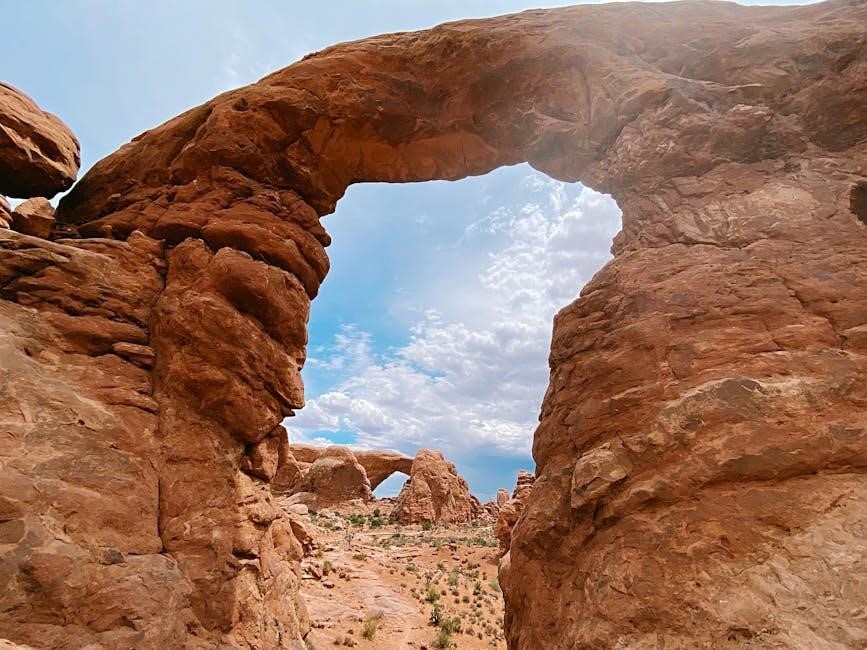
Geographical Location and Accessibility
Antelope Canyon is located near Page‚ Arizona‚ on Navajo Nation land. Accessibility is managed through guided tours‚ with water-based self-guided options available via Lake Powell.
Where is Antelope Canyon Located?
Antelope Canyon is situated on Navajo Nation land near Page‚ Arizona. It lies within the southwestern United States‚ close to Lake Powell and Horseshoe Bend. The canyon is divided into two main sections: Upper Antelope Canyon and Lower Antelope Canyon. Its strategic location makes it a popular day-trip destination for visitors staying in northern Arizona. The area is known for its stunning natural landscapes and is easily accessible by car or through nearby accommodations in Page.
How to Reach Antelope Canyon
Antelope Canyon is accessible by car or through guided tours. Fly into Phoenix Sky Harbor Airport‚ rent a vehicle‚ and drive to Page‚ Arizona. From Page‚ follow signs to the canyon. Guided tours are mandatory and must be booked in advance. Check tour company requirements for specific instructions. Consider combining your visit with nearby attractions like Horseshoe Bend or Lake Powell for a comprehensive experience. Ensure compliance with Navajo Nation regulations and permits. Plan ahead to ensure a smooth and enjoyable journey to this natural wonder.
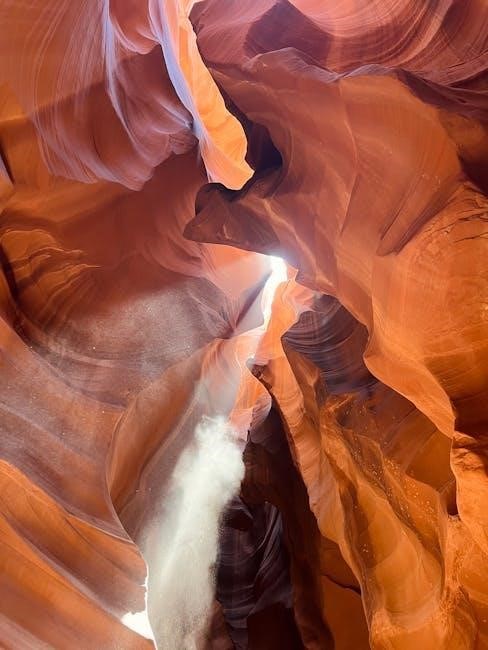
History and Geology of Antelope Canyon
Antelope Canyon‚ formed by millions of years of wind and water erosion‚ features smooth‚ wave-like rock formations. It holds deep cultural significance to the Navajo Nation.
Formation of the Canyon
Antelope Canyon was carved over millions of years by wind and water erosion‚ creating its iconic smooth‚ wave-like rock formations. Flash floods played a key role in shaping its depths. The canyon’s unique geological features are a result of the erosion of Navajo Sandstone‚ revealing vibrant colors and textures. Its formation is also tied to the region’s arid climate and the flow of nearby rivers. The canyon’s stunning natural beauty and intricate designs make it a fascinating subject for geological study and photography.
Cultural Significance to the Navajo Nation
Antelope Canyon holds deep cultural and spiritual significance for the Navajo Nation‚ who consider it a sacred site. Known as “Tse’ bighanilini‚” it symbolizes the connection between land‚ water‚ and life. The Navajo people believe the canyon holds spiritual energy and is often used in ceremonies. Its stunning formations are seen as a divine creation‚ reflecting the tribe’s rich heritage. The Navajo Nation manages the site to preserve its cultural integrity‚ ensuring visitors respect its sacred nature while experiencing its natural beauty.
Photography Opportunities in Antelope Canyon
Antelope Canyon is a photographer’s paradise‚ offering stunning light beams and vibrant rock formations. Its iconic beauty makes it a popular spot for capturing breathtaking images.
Best Times for Capturing Light Beams
The optimal time to capture light beams in Antelope Canyon is between 11 AM and 1 PM when sunlight streams through the narrow openings. Early morning offers softer light‚ while midday provides the most dramatic beams. Summer months guarantee the brightest illumination‚ but spring and fall also offer stunning conditions. Visitors should plan their tours during these peak hours to maximize photo opportunities‚ as the light beams are a key feature of the canyon’s allure.
Recommended Camera Gear for the Tour
A DSLR or mirrorless camera with a wide-angle lens is ideal for capturing Antelope Canyon’s vast interiors. A tripod is essential for stability in low-light conditions. Neutral density (ND) filters can help manage harsh light beams‚ while a polarizing filter enhances color saturation. Bring extra batteries and memory cards‚ as facilities may be limited. Shoot in RAW format for better editing flexibility. Manuel mode and lower ISO settings are recommended to avoid grainy photos. Ensure your gear is ready to capture the canyon’s breathtaking beauty effectively.
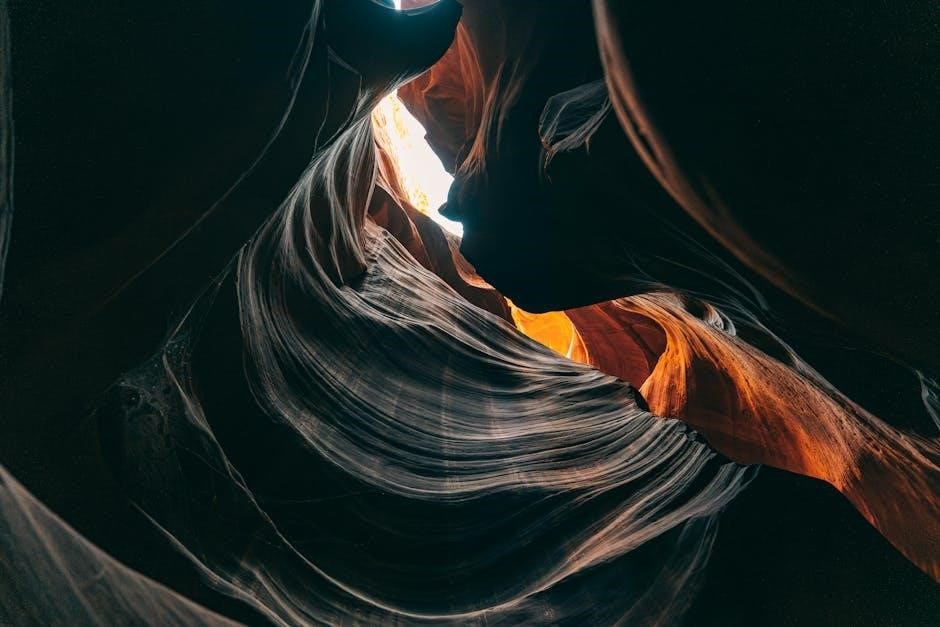
Guided Tours vs. Self-Guided Exploration
Self-guided land tours are prohibited‚ but water-based options like kayaking exist. Guided tours offer expert insights‚ safety‚ and compliance with Navajo regulations‚ with varying costs.
Why Guided Tours Are Mandatory
Guided tours are mandatory due to strict Navajo Nation regulations and safety concerns. The canyon’s fragile environment and cultural significance require expert guidance to preserve its natural beauty and historical importance. Visitors must stay with guides to avoid accidents and ensure responsible exploration. Self-guided land tours are prohibited‚ though water-based options like kayaking exist. Guides provide essential insights‚ navigate challenging terrain‚ and enforce rules to protect both visitors and the site. This ensures a safe and respectful experience for all while maintaining the canyon’s integrity for future generations.
What to Expect from a Guided Tour
A guided tour of Antelope Canyon offers a well-organized and enriching experience. Tours typically last 1.5 hours‚ with check-in required beforehand. Knowledgeable guides lead small groups through the canyon‚ sharing insights into its geology‚ history‚ and cultural significance. They assist with photography‚ ensuring visitors capture stunning images. The tour includes walking through the canyon’s narrow passages and admiring its iconic light beams. Guides emphasize safety and environmental respect. Visitors can explore both Upper and Lower canyons‚ each offering unique landscapes. The experience is both educational and visually breathtaking‚ making it a memorable adventure for all participants.
Upper Antelope Canyon vs. Lower Antelope Canyon
Upper Antelope Canyon is known for its iconic light beams and easier accessibility‚ while Lower Antelope Canyon offers longer‚ more adventurous trails with stunning geological formations.
Differences in Landscape and Accessibility
Upper Antelope Canyon features smoother terrain and iconic light beams‚ making it more accessible for visitors. Lower Antelope Canyon offers narrower passages and longer trails‚ providing a more adventurous experience. Both require guided tours‚ though Upper is generally easier to navigate due to shorter walks‚ while Lower involves more climbing and rugged paths. This contrast in landscape and accessibility caters to different preferences‚ with Upper being ideal for photography and Lower for those seeking a more immersive exploration of natural formations.
Choosing the Right Canyon for Your Visit
Choosing between Upper and Lower Antelope Canyon depends on your interests and physical condition. Upper Antelope Canyon is perfect for photography enthusiasts‚ with its stunning light beams and wide‚ accessible trails. Lower Antelope Canyon offers a more adventurous experience‚ with narrower pathways and longer hikes; Both require guided tours‚ but Upper is generally easier to navigate‚ making it ideal for families or those seeking a relaxed visit. If you prefer a more immersive and challenging exploration‚ Lower Canyon is the better choice.
Planning Your Visit
Plan your Antelope Canyon visit by booking a guided tour‚ as self-guided land exploration is prohibited. Check seasonal hours‚ permits‚ and weather forecasts to ensure smooth travel.
Best Time of Year to Visit
The best time to visit Antelope Canyon is during spring and fall when temperatures are mild‚ offering ideal conditions for photography and exploration. Summer months bring intense heat‚ while winters can be cool and less crowded. Guided tours are essential year-round‚ as self-guided land tours are not permitted. Plan your visit according to seasonal preferences and weather forecasts to make the most of your experience in this stunning natural wonder.
Cost of Tours and Permits
Tours of Antelope Canyon vary in cost‚ with Lower Antelope Canyon tours starting at $40 for a basic 1-hour tour‚ while deluxe options can reach up to $80. The Navajo Nation requires an $8 per person permit fee for entry. Prices generally include taxes and the permit‚ but this can vary by tour operator. Costs may increase for specialized tours‚ such as photography-focused excursions or private tours. It’s essential to check with tour providers for exact pricing and inclusions to plan your visit accordingly.
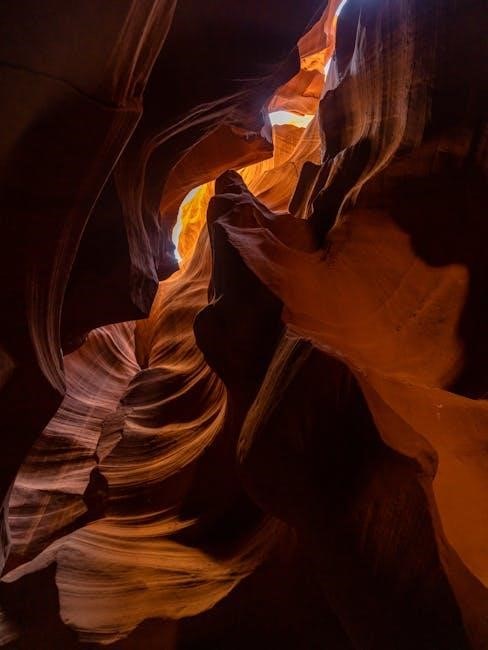
Safety and Regulations
Guided tours are mandatory for safety. Stay with your group‚ follow all rules‚ and pay the $8 Navajo permit fee to ensure a secure visit.
Safety Guidelines for Visitors
Self-guided land tours are prohibited; visitors must stay with licensed guides. Avoid restricted areas‚ as unstable terrain poses risks. Flash floods can occur‚ so follow guide instructions.
Ensure all permits are obtained‚ and respect Navajo Nation rules. Stay alert and keep children close. No solo exploration is allowed for safety reasons.
Environmental and Cultural Regulations
Visiting Antelope Canyon requires adherence to strict environmental and cultural regulations. The Navajo Nation mandates guided tours to protect the fragile ecosystem and sacred sites. Visitors must stay with guides‚ avoid touching walls‚ and refrain from removing rocks or artifacts. Permits are essential‚ and respect for Navajo traditions is paramount. Littering‚ vandalism‚ and unauthorized photography are prohibited. Strict rules ensure preservation of this natural and cultural treasure for future generations. Failure to comply may result in fines or legal action‚ emphasizing the importance of responsible tourism.
Nearby Attractions and Activities
Near Antelope Canyon‚ explore Horseshoe Bend‚ Lake Powell‚ and the Navajo Nation’s rich cultural sites. These attractions offer stunning landscapes and opportunities for outdoor adventures.
Combining Your Tour with Other Local Sights
Visitors to Antelope Canyon can easily combine their tour with nearby attractions like Horseshoe Bend and Lake Powell. Explore the stunning landscapes of Glen Canyon National Recreation Area or immerse yourself in the Navajo Nation’s rich cultural heritage. For adventure seekers‚ kayaking or paddleboarding on Lake Powell offers a unique way to experience the region’s natural beauty. These activities provide a well-rounded experience‚ making your trip to Antelope Canyon even more memorable and fulfilling.
Accommodation Options Near Page‚ Arizona
Page‚ Arizona offers a variety of accommodations‚ including hotels‚ lodges‚ and vacation rentals‚ catering to different traveler needs. These options are conveniently located near Antelope Canyon and other attractions like Lake Powell and Glen Canyon. Staying in Page provides easy access to guided tours and outdoor activities. It’s advisable to book in advance‚ especially during peak travel seasons‚ to ensure availability and make the most of your visit. This ensures a comfortable stay while exploring the region’s natural wonders.
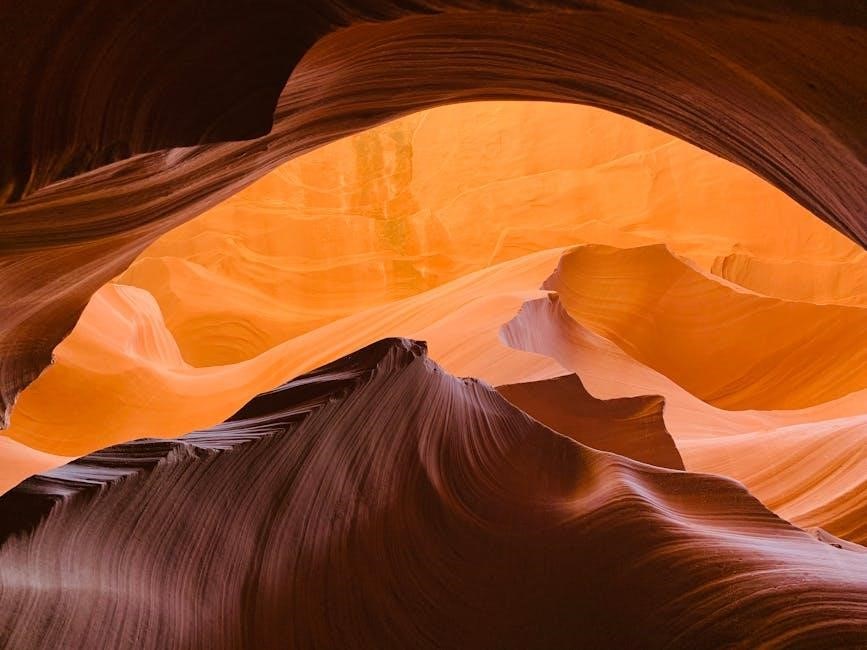
Tips for Making the Most of Your Tour
Book guided tours in advance‚ wear comfortable shoes‚ stay with your group‚ and bring a camera for stunning photos. Plan ahead for an unforgettable experience.
Preparing for the Physical Aspects of the Tour
Wear sturdy‚ comfortable shoes for hiking and climbing. Bring water‚ snacks‚ and sunscreen. Dress in layers for varying temperatures. Be prepared for uneven terrain and narrow passages. Visitors with mobility challenges should inform their guide in advance. While self-guided tours are not permitted‚ proper preparation ensures a smooth and enjoyable experience. Plan for physical exertion and potential crowds during peak seasons. Carry essential items like a backpack‚ extra batteries‚ and a first-aid kit. Stay hydrated and take breaks when needed to fully immerse in the canyon’s beauty.
Engaging with Your Tour Guide
Engage with your tour guide to enhance your Antelope Canyon experience. Ask questions about the canyon’s history‚ geology‚ and cultural significance. Guides often share fascinating stories and insights. They can also help you capture stunning photos by identifying prime spots and angles. Be respectful of their expertise and follow their instructions closely. Building a rapport with your guide ensures a safer and more enriching journey through the canyon’s breathtaking landscapes. Their knowledge will deepen your appreciation of this natural wonder and its cultural importance to the Navajo Nation.
Visiting Antelope Canyon offers an unforgettable experience. Remember to respect the land‚ culture‚ and guidelines. Plan responsibly and cherish the natural beauty and heritage of this iconic destination.
Final Thoughts on Visiting Antelope Canyon
Visiting Antelope Canyon is a unique opportunity to witness breathtaking natural beauty. While self-guided land tours are not permitted‚ guided tours offer insights into the canyon’s history and geology. For adventurers‚ kayaking or paddleboarding from Lake Powell provides a self-guided water-based experience. Respect the Navajo Nation’s rules and the fragile environment to preserve this wonder for future generations. Whether you’re a photographer or nature enthusiast‚ Antelope Canyon promises unforgettable memories and a deeper connection to the land and its cultural significance.
Encouragement to Respect the Land and Culture
Visitors are encouraged to deeply respect Antelope Canyon’s land and Navajo heritage. Follow all guidelines‚ avoid littering‚ and stay with guides to protect this fragile environment. Recognizing the canyon’s cultural significance fosters a meaningful connection. By honoring these principles‚ you contribute to preserving the canyon for future generations and uphold the Navajo Nation’s traditions. Your mindful actions ensure this natural wonder remains untouched and revered for years to come.
